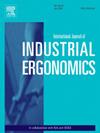Effects of control parameters of wearable robotics on muscle activity during assisted elbow flexion
IF 3
2区 工程技术
Q2 ENGINEERING, INDUSTRIAL
International Journal of Industrial Ergonomics
Pub Date : 2024-11-01
DOI:10.1016/j.ergon.2024.103660
引用次数: 0
Abstract
One way to provide assistance in a dynamic lifting task is to pre-emptively move the exoskeleton based on a predicted reference trajectory. However, the level of aggressiveness in the prediction (i.e., how far ahead in time) and the exoskeleton's degree of adherence to the reference trajectory (stiffness) are not yet fully understood. This study investigated the effects of stiffness and pre-emptive offset parameters in an impedance-controlled robotic arm on muscle activation and perceived exertion of the user. Thirteen participants were instructed to lift a load equivalent to 15% of their maximal voluntary contracted force in collaboration with a robotic arm with 40°–135° of elbow flexion in 1.12 s. Three levels of stiffness (lower: 0.1 N m deg−1, medium: 0.2 N m deg−1, and higher: 0.31 N m deg−1) and two levels of pre-emptive offsets (shorter: 0.1 s and longer: 0.4 s) were investigated. We found that (1) during 0–0.5 s (acceleration stage) of elbow flexion, a higher stiffness level and a longer pre-emptive offset decreased muscle activity; (2) during 0.5–1 s (deceleration stage) of elbow flexion, medium and higher stiffness with a shorter pre-emptive offset decreased muscle activity; (3) the perceived exertion and assistance of participants were improved with a higher stiffness and a longer pre-emptive offset, whereas cooperation was rated higher at a shorter pre-emptive offset under higher stiffness. This study reveals that the optimal parameters for stiffness and pre-emptive offsets for predictive impedance controls are different for different stages of elbow flexion.
可穿戴机器人的控制参数对辅助屈肘过程中肌肉活动的影响
在动态提升任务中提供帮助的一种方法是根据预测的参考轨迹预先移动外骨骼。然而,预测的积极程度(即提前多长时间)和外骨骼对参考轨迹的依附程度(刚度)尚未完全明了。本研究调查了阻抗控制机械臂的刚度和预先偏移参数对肌肉激活和使用者感知用力的影响。13 名参与者被要求在 1.12 秒内与机械臂合作举起相当于其最大自主收缩力 15%的重物,肘关节屈曲 40°-135°。研究了三种刚度水平(较低:0.1 N m deg-1;中等:0.2 N m deg-1;较高:0.31 N m deg-1)和两种抢先偏移水平(较短:0.1 秒;较长:0.4 秒)。我们发现:(1) 在屈肘 0-0.5 秒(加速阶段)期间,较高的硬度水平和较长的抢先偏移降低了肌肉活动;(2) 在屈肘 0.5-1 秒(减速阶段)期间,中等和较高的硬度水平和较短的抢先偏移降低了肌肉活动;(3) 在较高的硬度水平和较长的抢先偏移下,参与者的感知用力和协助得到改善,而在较高的硬度水平和较短的抢先偏移下,参与者的合作性评分较高。这项研究揭示了预测阻抗控制的僵硬度和抢先偏移的最佳参数在肘关节屈曲的不同阶段是不同的。
本文章由计算机程序翻译,如有差异,请以英文原文为准。
求助全文
约1分钟内获得全文
求助全文
来源期刊
CiteScore
6.40
自引率
12.90%
发文量
110
审稿时长
56 days
期刊介绍:
The journal publishes original contributions that add to our understanding of the role of humans in today systems and the interactions thereof with various system components. The journal typically covers the following areas: industrial and occupational ergonomics, design of systems, tools and equipment, human performance measurement and modeling, human productivity, humans in technologically complex systems, and safety. The focus of the articles includes basic theoretical advances, applications, case studies, new methodologies and procedures; and empirical studies.

 求助内容:
求助内容: 应助结果提醒方式:
应助结果提醒方式:


